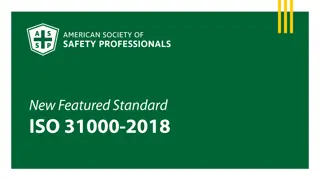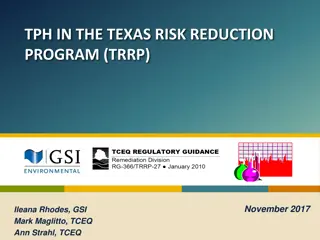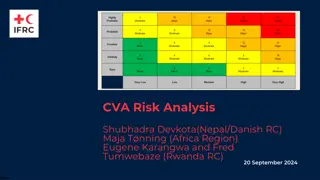Risk Analysis in Environmental Management: A Comprehensive Overview
Risk analysis plays a crucial role in environmental management, particularly in assessing potential health hazards and managing associated risks. This process involves risk assessment and risk management, with steps such as hazard identification, exposure assessment, dose-response assessment, and risk characterization. By analyzing statistical data and evidence, informed decisions can be made to reduce unacceptable risks. Dr. Mohab Kamal's course on Water Reclamation and Reuse delves deep into these concepts, providing a valuable understanding of environmental risk analysis.
Download Presentation

Please find below an Image/Link to download the presentation.
The content on the website is provided AS IS for your information and personal use only. It may not be sold, licensed, or shared on other websites without obtaining consent from the author. Download presentation by click this link. If you encounter any issues during the download, it is possible that the publisher has removed the file from their server.
E N D
Presentation Transcript
CE 445 Wastewater Reclamation and Reuse Dr. Mohab Kamal
Introduction to Risk Assessment When health effects can occur as the result of an environmental action, risk analysis is used to quantify the corresponding risks. Typically, a complete risk analysis is divided into two parts: Risk assessment Risk management Risk assessment involves the study and analysis of potential effect of certain hazards to human health. Using statistical information on cause and effect, risk assessment is intended to be a tool for making informed decisions. Risk management is the process of reducing risks that are determined to be unacceptable. CE 445 Water Reclamation and Reuse (Dr. Mohab Kamal) 2
Risk Assessment Environmental risk analysis takes place in four discrete steps: Hazard identification Exposure assessment Dose response assessment Risk characterization CE 445 Water Reclamation and Reuse (Dr. Mohab Kamal) 3
Risk Identification This step involves weighing the available evidence and determining whether a substance or constituent exhibits a particular adverse health hazard. As a part of hazard identification, evidence is gathered on the potential for a substance to cause health effects in humans or unacceptable environmental impacts. For humans, the principal sources for this information are clinical studies, controlled epidemiological studies, experimental animal studies and from evidence gathered from accidents and natural disasters. CE 445 Water Reclamation and Reuse (Dr. Mohab Kamal) 4
Exposure Assessment Exposure is the process by which an organism comes into contact with hazard. For humans, exposure can occur through different pathways including inhalation of air, ingestions of water or food, absorption through the skin via dermal contact, or absorption through the skin via radiation. The key steps in exposure assessment are identification of a potential receptor population, evaluation of exposure pathways and routes, and quantification of exposures. CE 445 Water Reclamation and Reuse (Dr. Mohab Kamal) 5
Dose-Response Assessment The fundamental goal of a dose- response assessment is to define a relationship (typically mathematical) between the amount of a toxic constituents to which a human is exposed and the risk that there will be an unhealthy response to that dose in humans. Typically dose-response relationships for carcinogenic and non-carcinogenic constituents are shown in this figure. It should be noted that it is assumed that there is no threshold for potentially carcinogenic constituents. CE 445 Water Reclamation and Reuse (Dr. Mohab Kamal) 6
Dose-Response Assessment Although the dose-response curve for a carcinogenic constituent is shown passing through the origin, data are not available at extremely low concentrations. Therefore, mathematical models have been developed to define the dose-response at low concentrations. Typical dose-response models that have been proposed are used for human exposure include: The single-hit model The multistage model The linear multistage model The multi-hit model The probit model CE 445 Water Reclamation and Reuse (Dr. Mohab Kamal) 7
Dose-Response Assessment CE 445 Water Reclamation and Reuse (Dr. Mohab Kamal) 8
Dose-Response Assessment The mathematical function used to describe the relationship between risk ad dose for the single-hit model is P(d) = 1 exp [-(qo qi d)] where P(d) = lifetime risk (probability) of developing cancer qo and qi = empirical parameters picked to fit the data d = dose The mathematical formulation used to describe the relationship between risk and dose for multistage model is P(d) = 1 exp ?=0 where P(d) = lifetime risk (probability) of developing cancer qi = empirical parameters picked to fit the data d = dose ? ???? CE 445 Water Reclamation and Reuse (Dr. Mohab Kamal) 9
Dose-Response Assessment The US EPA has defined lifetime risk as follows: Lifetime risk = CDI x PF where CDI = chronic daily intake over a 70-year lifetime, mg/kg.d PF = potency factor, (mg/kg.d)-1 The chronic daily intake (CDI) is computed as follows: ????? ????,?? ???????? ?,?? (????????,?) In its most general form, the total dose is defined as ???????????? ?????????????? ??? = exposure duration intake rate ab???????? factor Total dose = CE 445 Water Reclamation and Reuse (Dr. Mohab Kamal) 10
Dose-Response Assessment Recommended standard values for daily intake calculations have also been developed by EPA. The average body weights used for an adult and child are 70 and 10 kg, respectively and the corresponding rates of water ingestion are 2 and 1 liters per day. The potency factor, PF, often identified as the slope factor, is the slope of the dose-response curve, at very low doses. The US EPA has selected the linear multistage model as basis for assessing risk. CE 445 Water Reclamation and Reuse (Dr. Mohab Kamal) 11
Dose-Response Assessment Typical toxicity data for several chemical constituents are reported in the table below. CE 445 Water Reclamation and Reuse (Dr. Mohab Kamal) 12
Dose-Response Assessment Example 13 1: Risk Assessment for drinking groundwater containing trace amounts of N-Nitrosodimethylamine (NDMA) Estimate the incremental cancer risk for an adult associated with drinking 2 L per day of groundwater containing 2.0 g/L of NDMA using data from the integrated risk information system. To limit NDMA exposure to acceptable cancer risk of 1 to 100,000, determine the concentration of NDMA that can be allowed in extracted groundwater. CE 445 Water Reclamation and Reuse (Dr. Mohab Kamal) 13
Dose-Response Assessment Example 13 1: Risk Assessment for drinking groundwater containing trace amounts of N-Nitrosodimethylamine (NDMA) Solution: 1. Compute CDI = (average daily dose, mg/d)/(body weight, kg) = ( 2.0 g/L) (2 L/d) (1 mg/103 g) / 70 kg = 0.57 x 10-4 mg/kg.d 2. Compute the lifetime risk, Incremental lifetime risk = CDI x PF PF for NDMA (oral route) = 5.1 x 10 (mg/kg.d)-1 Incremental lifetime risk = 0.57 x 10-4 x 5.1 x 10 From the results of this analysis, estimated probability of developing elevated cancer risk as a result of drinking the groundwater containing 2.0 g/L of NDMA is 2.9 per 1000 person. = 2.9 x 10-3 CE 445 Water Reclamation and Reuse (Dr. Mohab Kamal) 14
Dose-Response Assessment Example 13 1: Risk Assessment for drinking groundwater containing trace amounts of N-Nitrosodimethylamine (NDMA) Solution: 3. Determine the concentration of NDMA to limit the acceptable cancer risk to 1 in 100,000 a. Estimate the CDI 10-5 = CDI x 5.1 x 10, therefore, CDI = 1.96 x 10-7 mg/kg.d b. Estimate the concentration of NDMA (C) (2 L/d) (1 mg/103 g) / 70 kg = 1.96 x 10-7 mg/kg.d C = 0.0069 g/L = 6.9 ng/L CE 445 Water Reclamation and Reuse (Dr. Mohab Kamal) 15
Risk Characterization The final step in risk assessment is risk characterization, in which the question of who is affected and what are the likely effects are defined to the extent they are known. Risk characterization involves the integration of exposure and dose-response assessments to arrive at the quantitative probabilities that effects will occur in humans for a given set of exposure conditions. CE 445 Water Reclamation and Reuse (Dr. Mohab Kamal) 16
Risk Assessment in Standard Setting An acceptable risk of 1 in 10,000 is often used in environmental risk assessment. Risks of less than 1 in 10,000 are considered minimal. CE 445 Water Reclamation and Reuse (Dr. Mohab Kamal) 17
Risk Management Risk management involves the development of standards and guidelines and management strategies for specific constituents including both toxic constituents and infectious agents. For example, if a toxic constituent or infectious microorganisms are present at higher than the maximum allowable concentration based on the risk assessment, risk management involves the determination of what management and /or technology is necessary to limit the risk to an acceptable level. Thus, the development and screening of alternatives; selection, design, and implementation; and monitoring and review are important elements of health risk management. CE 445 Water Reclamation and Reuse (Dr. Mohab Kamal) 18
Ecological Risk Assessment Ecological risk assessment is similar to risk assessment for humans in that the ecological effects of exposure to one or more stressors are assessed. A stressor is defined as a substance, circumstance, or energy field that can cause an adverse effect on a biological system. It should be noted that ecological risk assessments are undertaken for a variety of reasons such as to assess the potential impacts of the discharge of treated effluent to an existing wetland or applying bio-solids on land. CE 445 Water Reclamation and Reuse (Dr. Mohab Kamal) 19
Ecological Risk Assessment The framework for ecological risk assessment involving: 1. Problem formulation, in which the characteristics of the stressor are identified 2. Identification and characterization of the ecosystem at risk and the exposure modes. 3. Identification of likely ecological risks 4. Risk characterization, in which all of the information and data are integrated along with input from risk manager. CE 445 Water Reclamation and Reuse (Dr. Mohab Kamal) 20
Environmental Impact Assessment of Various Pollutants on Public Health and the Environment Pathogenic Microorganisms and Trace Organics Public Health dysentery, salmonellosis, infectious hepatitis, cholera, typhoid Infiltration into potable water supplies Irrigation of crops that are eaten uncooked Aerosols from specific irrigation processes Environmental Impact Effect on terrestrial life Heavy Elements Public Health nervous system disorders, mutagenesis, teratogens, carcinogenesis Bioaccumulation (food chain on crops and animals) Surface water pollution Environmental Impact acute and chronic toxicity for plant and animal life, chronic degradation effect on soil. CE 445 Water Reclamation and Reuse (Dr. Mohab Kamal) 21
Environmental Impact Assessment of Various Pollutants on Public Health and the Environment Nutrients Public Health blue-baby syndrome (form NO3) Infiltration into potable water supplies Environmental Health Eutrophication, crop yield effects (+ve & -ve) Surface water pollution Irrigation practices Dissolved Solids (Salinity) Environmental Health Induce problems for the crops yield selection and quantity Accumulation in soil Effect on soil permeability Clogging drip-irrigation systems CE 445 Water Reclamation and Reuse (Dr. Mohab Kamal) 22
Environmental Impact Assessment of Various Pollutants on Public Health and the Environment Emerging Pollutants Public Health Acute and chronic health effects effect on growth, reproduction problems Inadequate, or no information CE 445 Water Reclamation and Reuse (Dr. Mohab Kamal) 23
Environmental Impact Assessment of Agricultural Irrigation on Public Health and Environmental Issues Eutrophication Increased nutrients in surface waters Groundwater contamination Nitrate contamination on private drinking wells Biological Aerosols Gastrointestinal problems in nearby communities Antibiotics Odor Public health of neighboring communities Aesthetic concern reduced land values CE 445 Water Reclamation and Reuse (Dr. Mohab Kamal) 24
Environmental Impact Assessment of Agricultural Irrigation on Public Health and Environmental Issues Marketability Public acceptance Effect on Soil Regarding Salinity Increased osmotic pressure on plants Specific Ion Toxicity Worse in hot and arid regions (due to high evapotranspiration) Nutrients Water infiltration Rate CE 445 Water Reclamation and Reuse (Dr. Mohab Kamal) 25
Environmental Impact Assessment of Industrial Reuse and Non-potable Urban Uses on Public Health and Environmental Issues Public Health Concerns Aerosol transmission of organics Pathogens in cooling Pathogens in boiler feed water Concerns with Industrial Processes Scaling Corrosion Biological growth and fouling CE 445 Water Reclamation and Reuse (Dr. Mohab Kamal) 26
Environmental Impact Assessment of Groundwater Recharge on Public Health Issues Organic Chemicals Toxicological effects TDS Metals Pathogens Nitrates Methemoglobinemia CE 445 Water Reclamation and Reuse (Dr. Mohab Kamal) 27























